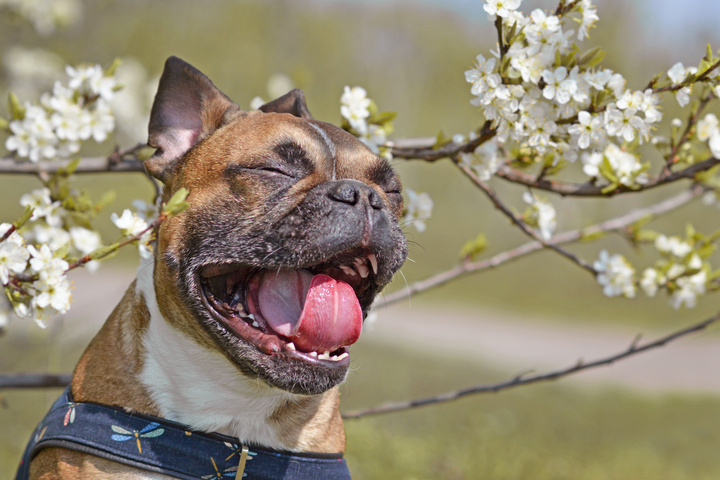Reverse sneezing in dogs can be alarming, but it isn’t as bad as it sounds. In fact, this common respiratory episode, also called inspiratory paroxysmal respiration, rarely requires treatment and usually goes away on its own.
That said, reverse sneezing can be distressing to watch, especially if you don’t know what’s happening or how to help your dog. Here’s more information on reverse sneezing and a few tricks to help instantly fix it.
What is reverse sneezing?
Instead of forcefully exhaling, like during a normal sneeze, reverse sneezing occurs when dogs rapidly inhale air through their noses. Think of it like your dog is sucking in a sneeze instead of blowing it out.
During a reverse sneezing episode, most dogs stand still and stick out their necks, often pulling back their lips and contracting and expanding their chests. This produces a loud snorting or huffing sound that can sometimes sound like a goose honking.
Note: Reverse sneezes sound different from the honking noise of a tracheal collapse or kennel cough. It’s a good idea to look up examples of both so that you can tell the difference.
Because it produces such a strange noise, it can seem like your dog is in respiratory distress, choking, or having trouble breathing. Thankfully, reverse sneezes are harmless and painless, and your dog will return to normal following the episode, which can last anywhere from 30 seconds to a couple of minutes.
What causes reverse sneezing?
Like regular sneezing, reverse sneezing has various potential causes but is often triggered by nose, throat, or sinus irritation. Anything that can cause your dog to sneeze regularly can also cause a reverse sneeze, making it hard to find an exact cause.
Here are some common situations that could cause reverse sneezing in dogs:
- Strong or chemical smells (cleaning products, air fresheners, perfumes)
- Exercise intolerance
- Eating or drinking quickly
- Foreign body in their throat or nasal cavity (grass, dust, seeds, etc.)
- Allergies to pollen, mold, dust mites, or certain foods
- Over excitement or stress during playtime, car rides, visits to the veterinarian, or other anxiety-inducing situations
- Smoke
- Nasal mites
- Pulling too hard on the leash
All dogs, regardless of age, breed, or gender, can experience this condition. Certain brachycephalic breeds, like French bulldogs and pugs, have a shortened head and an elongated soft palate, making them more prone to reverse sneezing episodes. Smaller dogs are also more susceptible.
How to instantly fix reverse sneezing
The occasional reverse sneezing incident isn’t anything to worry about. There are no lasting health repercussions, and it isn’t any more concerning than a regular sneeze. Most episodes are short and infrequent and will resolve on their own.
Though reverse sneezing isn’t harmful, it can be distressing to watch! To help your dog through a reverse sneezing episode, stroke their throat or the side of their face to induce swallowing. They will stop sneezing and return to normal once they swallow or exhale through their nose.
Here are some other methods you can try to stop a reverse sneezing episode:
- Lightly blow in their face
- Gently pet them to help them calm down and breathe normally
- Hold their muzzle and close one nostril for about five seconds
- Put your finger in the side of their mouth to encourage them to swallow (only do this if you know your dog won’t try to bite you)
- Stay calm and don’t panic — panicking can increase your dog’s anxiety
- Try to offer them a treat or something to drink
When to take your dog to the vet
Reverse sneezing isn’t concerning by itself but it could be connected to an underlying health issue, especially if your dog has just started reverse sneezing or it occurs many times each day.
Seek veterinary advice if:
- Episodes become frequent or prolonged
- Your dog shows signs of distress or discomfort during episodes
- They have additional symptoms such as nasal discharge, coughing, or difficulty breathing accompany reverse sneezing
- You suspect an underlying medical condition
If your dog has persistent reverse sneezing episodes (more than twice in a 24-hour period), visit your vet to rule out any potential causes. Your dog might be having an allergic reaction or could have an irritant lodged in their airway. They might also have canine nasal mites, a parasite in the sinuses that can cause intense itching.
Try to take a video of the attack if possible. Your dog is unlikely to have a reverse sneezing episode in the office, and it could be helpful to show your vet exactly what’s happening.
Most cases of reverse sneezing are benign, but your vet may prescribe an antihistamine, decongestant, or anti-inflammatory medication to help. During the visit, the veterinarian may perform a number of tests to rule out potentially severe health issues such as tracheal collapse or nasal tumors, especially if there are other connected symptoms.
Reverse sneezing: Not as bad as it seems!
Reverse sneezing might look and sound like your dog is having a significant health emergency, but thankfully, it isn’t as serious as it seems! Most dogs experience reverse sneezing at some point, which rarely indicates an underlying health concern. With this instant fix, you can be prepared to help your dog calm down and return to normal in no time.






